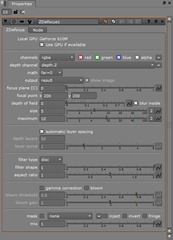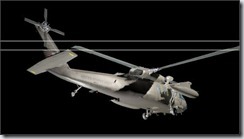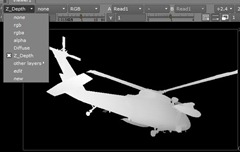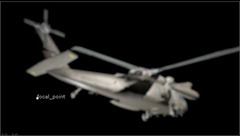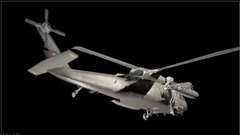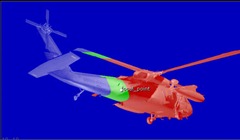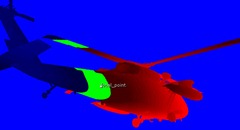The compositing of images implies combining multiple images to create a single seamless image. In this tutorial, we will create a simple composite using the
Read and
Merge Nodes. The nodes in the merge category are used to composite two or more images. Before we dive into the tutorial, lets first understand how the
Merge,
Premult, and
Unpremult nodes work.
MERGE NODE
The
Merge node combines two input images based on the transparency (alpha channel) using various algorithms. The alpha channel is used to determine which pixels of the foreground image will be used for the composite. This node takes three inputs:
A,
B, and
mask. The
A input is used to connect foreground image to the
Merge node. This image merges with the image that is connected to the
B input. When you connect an image to the
A input of the
Merge node, an additional
A input will be displayed on it, refer to Figure 1.
 |
| Figure 1 Additional input A displayed on the Merge1 node |
Each input is named in the order it was connected with other nodes,
A1,
A2,
A3, and so on. It means that you can connect as many images as you need on the
A side of a
Merge node. NukeX copies data from the
A input to the
B input. If you disconnect the node connected to the
A input, the data stream will still flow down as NukeX will use the
B input. The
mask input is used to connect a node to use as a mask.
The
Merge node connects multiple images using various algorithms such as
multiply,
overlay,
screen, and so on. To add a
Merge node to the workspace, press the M key; the
Merge# node will be inserted in the
Node Graph panel and its properties panel will be displayed with the
Merge tab chosen in the
Properties Bin, refer to Figure 2. The options available in the
Merge tab of the
Merge# node properties panel are discussed next.
 |
| Figure 2 The Merge# node properties panel |
operation
The options in the operation drop-down are used to set the algorithm to be used for merging the images. By default, the over algorithm is selected in this drop-down. It layers the image sequence connected to the A input over the image sequence connected to the B input according to the alpha channel present in the A input.
Tip: To see the math formula for a particular merge algorithm, place the cursor over the operation drop-down; a tooltip will be displayed. This tooltip contains the information about the mathematics behind a merge operation.
When the
Video colorspace check box located next to the
operation drop-down is selected, NukeX converts all colors to the default 8-bit colorspace before compositing and then outputs them in linear colorspace. You can change the default colorspace for 8-bit files from the
Project Settings panel. To do so, hover the mouse over the workspace and then press S; the
Project Settings panel will be displayed. In this panel, choose the
LUT tab; the
Default LUT settings area will be displayed. Next, select the desired option from the
8-bit files drop-down, refer to Figure 3.
 |
| Figure 3 Partial view of the LUT tab of the Project Settings panel |
On selecting the
alpha masking check box located next to the
Video colorspace check box, the image is processed according to the PDF/SVG spec. According to this spec, that the input image remains unchanged if the other composited image has zero alpha. The calculation applied to the alpha will be according to the following formula: a+b-a*b. If this check box is cleared, the formula applied to alpha will be same as that applies to other channels.
Note: This check box will be disabled when it does not affect the operation selected from the operation drop-down or PDF/SVG.
set bbox to
The options in this drop-down are used to set the bounding box. The bounding box defines the area of the frame that is having valid image data. It is used to speed up the processing. By default, full image area is the bounding box of the input image but if you crop a particular input, the bounding box will be reduced to the cropped area. The default option in this drop-down is union, the other three are:
intersection,
A, and
B. These options are discussed next.
union
The union option combines the two bounding boxes from the
A and
B inputs. It resizes the output bounding box to fit the two input bounding boxes completely.
intersection
When you select the
intersection option, the output bounding box will be the overlapping area of the two input bounding boxes.
A
Select the
A option to use the bounding box from the
A input.
B
Select the
B option to use the bounding box from the
B input.
metadata from
The options in this drop-down are used to specify the node whose metadeta will flow down the process tree.
A channels
The options in the first
A channels drop-down are used to specify which channels from the
A input will be merged with the
B input. The options in the second
A channels drop-down are used to specify additional channel (alpha) to be merged with the
B input. If you select
none from the first
A channels drop-down, the output of the
A input will be black or zero. You can select check boxes on the right of the first
A channels drop-down to select individual channels.
B channels
The options in the first
B channels drop-down are used to specify which channels from the
B input will be merged with the
A input. The options in the second
B channels drop-down are used to specify additional channel (alpha) to be merged with the
A input. You can select the check boxes on the right of the first
B channels drop-down to select individual channels.
output
The options in the first
output drop-down are used to specify the output channels after the merge operation. The options in the second
output drop-down are used to specify an additional output channel (alpha) after the merge operation. You can select the check boxes on the right of the first output drop-down to select individual channels.
Note: There are four check boxes on the right of the A channels, B channels, and output drop-downs, namely red, green, blue, and Enable channel, refer to Figure 4. You can use these check boxes to keep or remove the channels from the merge calculations, as required. When the Enable channel check box is selected, the channels selected from the drop-down placed on the right of this check box are enabled. This check box is available in the properties panels of many nodes.
 |
| Figure 4 The Enable channel check boxes displayed in the Merge1 properties panel |
also merge
The options in the first
also merge drop-down are used to specify the channels that will be merged in addition to the channels specified from the
A channels and
B channels drop-downs. The options in the second
also merge drop-down are used to specify the additional channel (alpha) to be merged. You can select the check boxes on the right of the first
also merge drop-down to select individual channels. These check boxes appear when you select option other than none in the first
also merge drop-down.
mask
The Enable channel check box located on the left of the
mask drop-down is selected when you connect a mask to the
mask input of the
Merge node or select a channel from the
mask drop-down. The options in this drop-down are used to select the channel that will be used as mask. When the
inject check box is selected, NukeX copies the
mask input to the predefined
mask.a channel. The injected mask can be further used downstream in the process tree. By default, the merge is limited to the non-black areas of the mask. When you select the
invert check box, the mask channel will be inverted and now merge will be limited to the non-white areas of the mask. The
fringe check box is used to blur the edges of the mask.
mix
The
mix parameter is used to blend the two merged inputs. When the value of this parameter is set to 0, only the
B input will be displayed in the
Viewer# panel. The full merge will be displayed when the value for this parameter is set to 1 which is the default value.
PREMULT NODE
The
Permult node is used to premultiply the input image. This node multiplies the rgb channels of the input image with its alpha channel. The alpha channel is used to determine which pixels of the foreground input image will be visible in the final composite. An input image that is not premultiplied is referred to as straight or unpremultiplied. If the black areas in the alpha channel are not black in the color channels, then the image is considered as Straight. Generally, most 3D rendered images are premultiplied. The
Merge node expects premultiplied images so you should use the
Premult node before any merge operation if input image is not premultiplied. This helps in removing artifacts such as fringes around a masked object. While color-correcting a premultiplied image, you should first connect an
Unpremult node to the image and then perform color-correction. Next, connect a
Premult node to get back to original premultiplied state for the merge operations. To add a
Premult node to the
Node Graph panel, select
Premult from the
Merge menu of the
Nodes toolbar; the
Premult# node will be inserted in the
Node Graph panel and its properties panel will be displayed with the
Premult tab chosen in the
Properties Bin, refer to Figure 5. The options available in the
Premult tab of the
Premult# node properties panel are discussed next.
 |
| Figure 5 The Premult1 node properties panel |
multiply
The options in the first
multiply drop-down are used to set the channels (generally rgb) to be multiplied with the alpha channel. To select the individual channels, you can select the check boxes available on the right of the multiply drop-down. The options in the second
multiply drop-down are used to set the additional channel to be multiplied with the alpha channel.
by
If you select the Enable channel check box located on the left of the by drop-down, the channel set in it (generally alpha) is multiplied with the channels set using the
multiply drop-downs. The
invert check box is used to invert the output of the alpha channel.
UNPREMULT NODE
The
Unpremult node is used to divide the rgb channels of the input image by its alpha. To add a
Unpremult node to the
Node Graph panel, select
Unpremult from the
Merge menu; the
Unpremult# node will be inserted in the
Node Graph panel and its properties panel will be displayed with the
Unpremult tab in the
Properties Bin, refer to Figure 6. The options available in the
Unpremult tab of the
Unpremult# node properties panel are discussed next.
 |
| Figure 6 The Unpremult1 node properties panel |
divide
The options in the first
divide drop-down are used to set the channels (generally rgb) to be divided with the alpha channel. To select the individual channels, you can select the check boxes available on the right of the
divide drop-down. The options in the second
divide drop-down are used to set an additional channel to be divided with the alpha channel. The function of the by and
invert check boxes is same as discussed in the
Premult node.
TUTORIAL
In this tutorial, we will create a simple composite using the
sunset.jpg,
tree.png, and
man stading.png files. Figure 7, 8, 9, and 10 display the
sunset.jpg,
tree.png,
man standing.png, and the final output, respectively.
 |
| Figure 7 The sunset.jpg image |
 |
| Figure 8 The tree.png image |
 |
| Figure 9 The standing man.png image |
 |
| Figure 10 The final composite |
Step - 1
In your browser, navigate to
http://www.sxc.hu/photo/1252649; a image will be displayed. Next, download and save the image with the name sunset.jpg to your hard drive.
Step - 2
Navigate to the following link
http://www.mediafire.com/download/ob9on43alamlk0l/nt004.zip and download the zip file which contains the
png files. Next, extract the content of the zip file to the location where you have saved the
sunset.jpg.
Step - 3
Start Nuke and then create a new script by choosing
File > New from the menu bar.
Step - 4
Hover the cursor over the
Node Graph panel and press S; the
Project Settings panel is displayed in the
Properties Bin. Make sure the
Root tab is chosen in it and then select
NTSC_16:9 720x486 1.21 from the
full size format drop-down.
Next, you will import images to the script.
Step - 5
Choose the
Image button from the
Nodes toolbar; the
Image menu will be displayed. Next, choose
Read from this menu; the
Read File(s) dialog box will be displayed. In this dialog box, navigate to the location where you have saved the
sunset.jpg and then choose the
Open button; the
Read1 node will be inserted in the
Node Graph panel.
Step - 6
Make sure the
Read1 node selected in the
Node Graph panel and then press 1 to view the output of the
Read1 node in the
Viewer1 panel.
Step - 7
Choose the
Transform button from the
Nodes toolbar; the
Transform menu is displayed. Next, choose
Reformat from this menu; the
Reformat1 node will be added to the
Node Graph panel and a connection will be established between the
Read1 and
Reformat1 nodes.
Step - 8
Import
tree.png and
man standing.png files to the script, refer to step 5, the
Read2 and
Read3 node will be added to the
Node Graph panel.
Step - 9
Make sure the
Read2 node is selected in the
Node Graph panel and then press 1; the output of the
Read2 node is displayed in the
Node Graph panel. In the
Read tab of the
Read2 properties panel, select the
premultiplied check box.
Step - 10
Make sure the
Read3 node is selected in the
Node Graph panel and then press 1; the output of the
Read3 node is displayed in the
Node Graph panel. In the
Read tab of the
Read3 properties panel, select the
premultiplied check box.
Step - 11
Select the
Reformat1 node in the
Node Graph panel and then press 1 to view the output of the
Reformat1 node in the
Viewer1 panel.
Step - 12
Select the
Read2 node in the
Node Graph panel and then press M; the
Merge1 node will be inserted in
Node Graph panel and a connection will be established between the
Read2 and
Merge1 nodes.
Step - 13
Drag the
Merge1 node onto the pipe connecting
Reformat1 and
Viewer1 nodes. Also, the output of the
Merge1 node will be displayed in the
Viewer1 panel.
Step - 14
Insert a
Reformat node between the
Read2 and
Merge1 nodes.
Step - 15
Select the
Reformat2 node in the
Node Graph panel and then press C; the
ColorCorrect1 node is inserted between the
Reformat2 and
Merge1 node.
Step - 16
In the
ColorCorrect tab of the
ColorCorrect1 node properties panel, enter
0 in the gain field.
Step - 17
Select the
Read3 node in the
Node Graph panel and SHIFT select the
Merge1 node. Next, press M the
Merge2 node will be inserted in the
Node Graph panel and a connection will be established between the
Merge1,
Merge2, and
Read3 nodes.
Next, you need to crop and scale down the output of the
Read3 node.
Step -18
Select the
Read3 node in the
Node Graph panel and then choose the
Crop node from the
Transform menu; the
Crop1 node will be inserted between the
Read3 and
Merge2 nodes.
Step - 19
In the
Crop tab of the
Crop1 node properties panel, enter
120,
335,
955, and
1780 in the box
x,
y,
r, and
t fields, respectively.
Next, you will scale down and position the output of the
Crop1 node.
Step - 20
Select the
Crop1 node in the
Node Graph panel and then add
Transform node from the
Transform menu; the
Transform1 node will be inserted between the
Crop1 and
Merge2 nodes.
Step - 21
In the
Transform tab of the
Transform1 node properties panel, enter -
853 and
-845.4 in the
translate x and
y fields, respectively.
Step - 22
Enter
0.066 in the
scale field.
Next, you will apply an overall color-correction.
Step - 23
Select the
Merge2 node in the
Node Graph panel and then press C; the
ColorCorrect2 node is inserted in the
Node Graph panel and a connection is established between
Merge2 and
ColorCorrect2 nodes.
Step - 24
In the
ColorCorrect tab of the
ColorCorrect1 node properties panel, expand the
master area, if already not expanded. Next, choose the
Channel chooser button corresponding to the
gamma parameter and then enter
0.7614 and
0.48 in the
g and
b fields, respectively.
Step - 25
Save the composition. Figure 11 shows the node network used in the script.
 |
| Figure 11 The node network used in the script |













